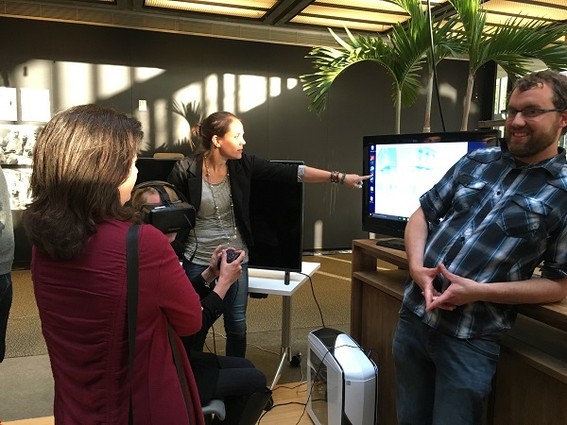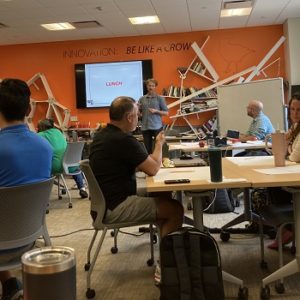2016 A Watershed Year for VR, Tammy Laverty of Atomic Veggie Studios Tells Meetup

This year has been a breakthrough year for virtual reality, augmented reality and mixed reality, said Tammy Laverty, cofounder of Atomic Veggie Studios(Middletown), at the NJ Strategic Design + Tech meetup at Bell Works (Holmdel) in May. Tammy, along with husband and cofounder Matt Laverty, gave an overview of what’s going on in this area.
Atomic Veggie Studios specializes in the “Wow!” factor, Tammy, who made the formal presentation, told the crowd. “The easiest way to explain that is that we do animation, 2D, 3D, motion graphics, virtual reality and augmented reality. We do apps — right now we’re working on virtual reality apps for education and we’re doing some for history. We are also working on our own game that I’m excited about, and hopefully we’ll be releasing that to the Oculus Store later this year”
The company is working with the Cony Island USA to rebuild a turn-of-the-century version of Luna Park, a now defunct amusement park. “We’ve built 3D models of it. We are going to be making it a beautiful space that people can go to from anywhere in the world and maybe even go on some of the old rides.”
Laverty said that some VR and AR apps and devices can cause “vection,” or motion sickness directly related to the headsets that are used. “What happens is that you are moving, and your eyes turn back and your body says ‘no you’re not moving,’ and so the result is that you feel sick, depending on the virtual experience that you are in.” When you are designing content for VR, you have to be very careful about the user experience, she noted.
What’s different about 2016?
The reason 2016 has been a historic year for VR, Laverty continued, “is because of the hardware releases that are coming out.” She noted that Sony, Oculus and HTC all have major hardware releases in 2016, although Sony’s isn’t scheduled to come out until October. “It’s about hardware releases, it’s about accessibility, and it’s about exciting content,” she continued.
VR has been around for years, she acknowledged. But what’s making this industry explode is that mobile and VR are coming together. “You already have the equipment in your pocket, or you will when the company forces you to upgrade. Everybody’s got the equipment already, all you need is the headset.”
Laverty went into some definitions. Examples of VR hardware are Google Cardboard, Oculus Rift, and Samsung Gear. With VR, you have two different screens that are slightly altered so each eye is getting to see its own little view, and it makes it feel as if the VR were all around you. An example of AR is Microsoft HoloLens. With HoloLens, “you can see this person is driving. It’s projecting where their turn is supposed to go. AR is imposed over your actual view.”
Mixed reality is very similar to AR, she said. Both are imposed on what you see in front of you, the difference is that mixed reality… actually takes an everyday object and imbues it with digital content that attaches to it.
VR gear can be pretty expensive. Head-mounted displays that are used for AR or VR vary in their degrees of complexity. “In the spectrum of expensive to not expensive, your least expensive would be Google Cardboard, which is actually a handmade one.”
Samsung Gear delivers a mid-level experience. “It’s actually not that cheap, but if you have the phone it’s only about $100.” The most expensive head gear comes from Oculus and HTC Vive. Both headsets keep you tethered to your chair, she said, but they also have the processing power of your computer behind it. “What it comes down to is cost versus convenience, and you have to decide that for yourself,” she said.
Google’s Plans for VR
Laverty talked about Google’s plans, which had only been announced that same day at Google I/O. “Google wants to go deeper into mobile VR. They want to create something that competes with Samsung Gear. They are releasing a new VR platform called “Daydream,” which is built for a new line of VR-ready Android phones (to be released this fall) that will support mobile motion controllers and will come with cutting-edge lenses and other enhancements for the mobile VR experience.
One problem with earlier VR systems is they didn’t let customers use their hands, but newer ones like HTC Vive do. Google wants to tap into this enhancement. “It’s a big deal that Google is going to be doing this because it works for mobile. They will be partnering with HTC, Samsung and others. That’s another big deal because you have a lot of big players involved. The bad news is that you have to buy the newest Android phones. It’s only going to work with special phones with special lenses, which will be Daydream-ready.”
Qualcomm, which makes “a lot of what gives higher-end phones their power,” believes that it can get more juice by shrinking big computers down to a size that fits into phones. Laverty quoted a Qualcomm VP as saying, “It just became apparent that a headset was going to be a better way of getting info into people’s visual cortexes.”
Getting back to AR and mixed reality, Laverty said that the big player is Microsoft HoloLens. Magic Leap is another, but it’s a “mystery dark horse we don’t know much about, but is very heavily funded.” Also there’s another headset, called “Meta 2.”
With AR, users see what is around them, so the biggest challenge is to map the space, she said. AR has a very narrow field of vision, and the biggest complaint from users is that the images fade out as a player moves, “which is a big challenge.”
There are also some “insane cameras” coming out, she said. “They really look like something out of Star Wars, right? That’s the Nokia Ozo.” A less expensive option is the Bublcam; it’s a $300 camera you can go out and shoot with your friends if you want. A professional camera by Lytro creates so much data that it comes with its own server to catch the flood of raw data coming in, she noted. “What’s cool about it is it lets you take different points of view within a space. It records the light emitted from a space.”
Summing up, Laverty noted that Chris Milk is one of her favorite VR producers right now. She quoted him as saying, “The more great experiences you’re having, the more interested you are going to be in moving up to the next level of immersion. Once you move past the spectacle and the hype, VR is a medium of human experience. So, really, what it’s all about is how can you bring people into the stories and how can you connect people to one another. And that’s really the power of what VR is.”
And she also referred to some remarks by Palmer Luckey, founder of Oculus. He had said that, as he’s observing what people are actually picking up from a story, he is finding that it is really short experiences that they want. This shorter experience doesn’t act like a movie or a TV show. It’s not going to make you sick. It’s going to get people excited.

